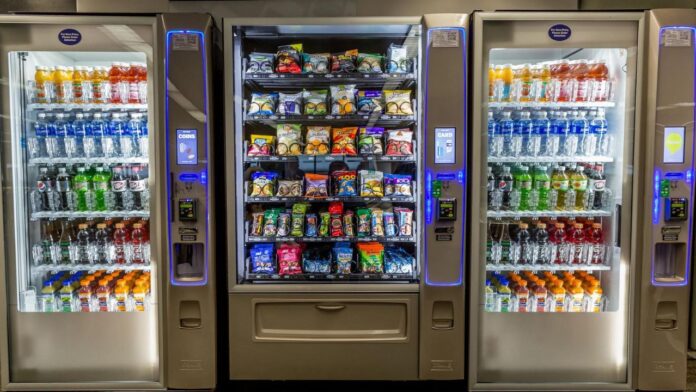How Much Electricity Does a Vending Machine Use? Vending machines are automated retail units that dispense products to customers at the push of a button or the insertion of currency. They can be found in many locations, including office buildings, schools, airports, and shopping malls. While these machines provide convenience and accessibility, they also consume electricity to power their operation.
The Basics of Vending Machines
To accommodate a variety of product varieties and customer preferences, vending machines are available in a range of sizes and designs. Some common types include snack vending machines, beverage vending machines, and combination machines offering snacks and drinks. These machines are typically equipped with refrigeration units to keep perishable items fresh.
Finding Out Electricity Consumption
The amount of electricity a vending machine consumes depends on several factors, including the type of machine, its size, and the products it dispenses. Although vending machines are generally designed to operate efficiently, their energy usage can still vary significantly.
Factors that influence electricity consumption include the power requirements of the machine’s internal components, such as the refrigeration system, lighting, and payment mechanisms. Additionally, the frequency of use and ambient temperature can impact energy usage, as machines may need to work harder to maintain optimal conditions in warmer climates.
Calculating Electricity Consumption
To estimate the electricity consumption of a vending machine, one must consider its power rating and the duration of operation. The formula for calculating energy usage is straightforward:
Energy Consumption (kWh)=Power Rating (kW)×Operating Hours
Energy Consumption (kWh)=Power Rating (kW)×Operating Hours
For example, if a vending machine has a power rating of 0.5 kW and operates for 10 hours per day, the daily energy consumption would be:
Energy Consumption=0.5 kW×10 hours=5 kWh
Energy Consumption=0.5 kW×10 hours=5 kWh
Impact on Energy Bills
For businesses that operate vending machines, electricity consumption can significantly impact operational costs. High energy usage can lead to inflated utility bills, reducing overall profitability. Moreover, excessive energy consumption contributes to carbon emissions and environmental degradation, highlighting the importance of energy efficiency.
Efficiency Measures
To minimize electricity consumption and lower operating costs, businesses can take several measures to improve the energy efficiency of their vending machines. Investing in energy-efficient models with advanced insulation and temperature control systems can significantly reduce power requirements. Regular maintenance, such as cleaning condenser coils and replacing worn-out components, can also improve efficiency and prolong the lifespan of vending machines.
Regulations and Standards

In response to growing concerns about energy consumption and environmental sustainability, governments worldwide have implemented regulations and standards to promote energy efficiency in vending machines. These regulations may include minimum energy performance standards and labeling requirements to inform consumers about the energy efficiency of different models. Certification programs, such as ENERGY STAR, help businesses identify and select energy-efficient vending machines that meet specific criteria.
Case Studies
Several businesses have successfully implemented energy-saving measures to reduce the electricity consumption of their vending machines. These companies have achieved significant cost savings by upgrading to energy-efficient models and adopting maintenance best practices while minimizing their environmental footprint. For example, a recent study found that a company that replaced old vending machines with ENERGY STAR-certified models reduced its energy consumption by 30% and saved thousands of dollars annually on utility bills.
Future Trends
As technology advances, the future of vending machines looks promising regarding energy efficiency. Manufacturers are developing innovative solutions, such as solar-powered vending machines and smart energy management systems, to reduce electricity consumption further and increase sustainability. These advancements benefit businesses by lowering operating costs and contributing to global efforts to combat climate change and preserve natural resources.
Average Power Consumption of Vending Machines

Vending machines have become ubiquitous daily, offering convenient access to snacks, beverages, and other goods in various locations such as office buildings, schools, hospitals, and transportation hubs. However, with the increasing focus on energy efficiency and sustainability, understanding the average power consumption of vending machines has become crucial for businesses and consumers alike.
Several factors come into play when considering the average power consumption of vending machines. These factors include the type of vending machine, its size, the products it dispenses, and its operational hours. Generally, vending machines are designed to operate efficiently, but their energy usage can vary significantly based on these factors.
One of the primary determinants of a vending machine’s power consumption is its internal components. Vending machines typically incorporate refrigeration units to keep perishable items fresh, lighting systems for visibility, and electronic payment processing mechanisms, contributing to the machine’s overall electricity consumption.
The size and capacity of a vending machine also influence its power requirements. Larger vending machines with multiple compartments and higher storage capacities may consume more electricity than smaller, more compact models. Additionally, the type of products dispensed by the vending machine can impact its energy usage. For example, machines that dispense cold beverages or frozen foods may require more power to maintain optimal temperatures than machines that only dispense non-perishable items.
Another critical factor affecting the average power consumption of vending machines is their operational hours. Vending machines that are constantly used or located in high-traffic areas may consume more electricity than those with limited operating hours or placed in less frequented locations. Additionally, ambient temperature plays a role in energy consumption, as vending machines may need to work harder to maintain desired temperatures in warmer climates.
To estimate the average power consumption of a vending machine, one can use the formula:
Average Power Consumption (kWh)=Power Rating (kW)×Operating Hours
Average Power Consumption (kWh)=Power Rating (kW)×Operating Hours
For example, if a vending machine has a power rating of 0.5 kW and operates for 10 hours per day, its daily energy consumption would be:
Average Power Consumption=0.5 kW×10 hours=5 kWh
Average Power Consumption=0.5 kW×10 hours=5 kWh
However, it’s essential to note that this is just an estimate, and actual power consumption may vary based on machine efficiency, maintenance, and environmental conditions.
Businesses that operate vending machines must consider the impact of energy consumption on their operational costs and environmental footprint. High energy usage can lead to inflated utility bills, reducing overall profitability. Moreover, excessive electricity consumption contributes to carbon emissions and environmental degradation, underscoring the importance of energy efficiency in vending machine operations.
Vending machine manufacturers have developed energy-saving features and technologies to mitigate the environmental and financial impacts of high energy consumption. These features aim to minimize electricity usage without compromising the machines’ performance or functionality.
Energy Saving Features of a Vending Machine
Advanced insulation and temperature control systems are one of the primary energy-saving features in modern vending machines. These systems are designed to minimize heat transfer and maintain consistent internal temperatures, reducing the workload on refrigeration units and lowering overall energy consumption.
Additionally, many vending machines now come equipped with LED lighting systems, which consume significantly less power than traditional fluorescent or incandescent bulbs. LED lights reduce electricity usage and offer superior brightness and longevity, further enhancing the energy efficiency of vending machines.
Another energy-saving feature commonly found in vending machines is intelligent power management technology. This technology allows vending machines to enter low-power modes during periods of inactivity, such as late at night or during low foot traffic. Intelligent power management systems help businesses save energy and reduce operating costs by reducing power consumption during idle periods.
Furthermore, some vending machine models incorporate motion sensors or proximity detectors to activate lighting and display screens only when a customer approaches. This prevents unnecessary energy usage when the machine is unused, enhancing energy efficiency.
In addition to these features, regular maintenance and servicing are essential for optimizing the energy efficiency of vending machines. Cleaning condenser coils, replacing worn-out components, and ensuring proper insulation are all critical steps in maintaining peak performance and minimizing energy consumption.
Overall, vending machines’ average power consumption varies depending on machine type, size, product offerings, and operational hours. However, businesses can reduce energy usage and lower operating costs by investing in energy-efficient vending machine models and implementing maintenance best practices.
How to Figure Out the Likely Energy Consumption of a Vending Machine
Understanding the energy consumption of your vending machine business is crucial for managing costs and optimizing efficiency.
Consider several factors to figure out the likely energy consumption of a vending machine. First, examine the specifications provided by the manufacturer, including the power rating of the machine and any energy-saving features it may have. Next, estimate the average daily operating hours of the vending machine, taking into account peak usage times and any downtime periods.
With this information, use a simple formula to calculate the daily energy consumption: Energy Consumption (kWh) = Power Rating (kW) × Operating Hours. By following these steps and considering factors such as machine type and environmental conditions, you can gain valuable insights into the energy usage of your vending machines and make informed decisions to optimize efficiency and reduce costs.
How to Save Money on Electricity When Running a Vending Machine Business
Running a successful vending machine business involves more than just stocking products and collecting revenue—it also requires careful management of operational expenses, including electricity costs.
To save money on electricity when running a vending machine business, consider implementing energy-saving strategies. Start by investing in energy-efficient vending machine models with features such as LED lighting, smart temperature control, and high-efficiency compressors.
These machines consume less power while maintaining optimal performance, lowering electricity bills. Additionally, schedule regular maintenance checks to ensure your machines operate efficiently, including cleaning condenser coils and inspecting insulation. By reducing energy waste and maximizing efficiency, you can significantly lower your electricity expenses over time, increasing profitability and sustainability for your vending machine business.
Conclusion
Learning the electricity consumption of vending machines is essential for businesses looking to optimize operational efficiency and minimize environmental impact. By implementing energy-saving measures, such as investing in energy-efficient models and adopting maintenance best practices, businesses can reduce their electricity consumption, lower operating costs, and contribute to a more sustainable future.
FAQ
How Much Electricity Does A Typical Vending Machine Consume?
The electricity consumption of a vending machine varies depending on factors such as its size, type, and operating hours. A typical vending machine consumes around 3 to 5 kWh of electricity per day.
Are There Any Regulations Governing The Energy Efficiency Of Vending Machines?
Many countries have implemented regulations and standards to promote energy efficiency in vending machines. These regulations may include minimum energy performance standards and labeling requirements.
What Are Some Energy-Saving Measures Businesses Can Take To Reduce Electricity Consumption?
Businesses can reduce electricity consumption by investing in energy-efficient vending machine models, implementing regular maintenance, and adopting smart energy management systems.
How Can Businesses Determine The Energy Efficiency Of Vending Machines Before Purchasing Them?
When purchasing vending machines, businesses can look for ENERGY STAR certification and other energy efficiency labels. These labels provide information about the energy performance of different models.
What Are The Long-Term Benefits Of Investing In Energy-Efficient Vending Machines?
Investing in energy-efficient vending machines can lead to significant cost savings on utility bills, reduce environmental impact, and enhance corporate sustainability initiatives.

